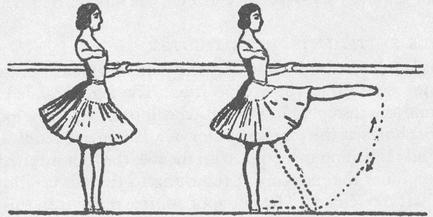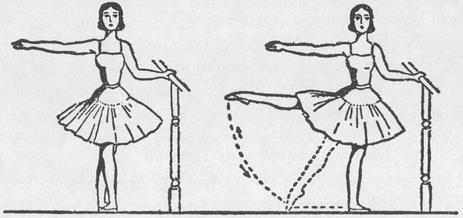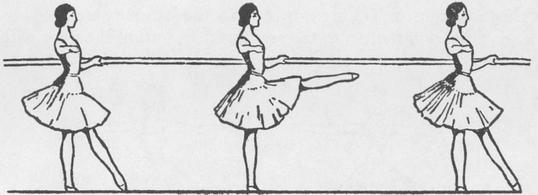Basic Principles of Classical Ballet (6 page)
Read Basic Principles of Classical Ballet Online
Authors: Agrippina Vaganova

This battement is the foundation of the entire technique. It was created by a genius who had penetrated into the very substance of the build and functions of the various ligaments of the leg.
A simple example from the everyday life of a dancer proves it fully. When a dancer, while dancing, slightly twists a leg and cannot step on her foot because of an uncomfortable feeling, she carefully begins to do battements tendus, and quickly regains working ability.
It is a custom to do battements tendus before a dance in order to warm up the legs. The legs not only get warmed up through this movement, but they also get into working condition; as our dancers say,
they are brought
up for the forthcoming activity, particularly in allegro.
When one observes that the legs of a dancer do not move properly, it is easy to guess that she has not been brought up by doing strict battements tendus at the proper time.
BATTLEMENTS TENDUS SIMPLES
At the beginning of the study, this battement may be done from the 1st position, as this is less complicated. However, the same rules must be observed as in the battement from the 5th position, which is described below, only the foot, naturally, must return into 1st position.
Feet in the 5th position, right one in the front. Arms are open in 2nd position
13
The weight of the entire body is on the left foot, right one free and not carrying any weight.
Right foot glides forward, without lifting the toe from the floor. The movement is begun by the whole extended foot. The heel is kept as much turned out as possible, which makes it feel as if the movement is begun by the heel. Then the movement is continued by the toes.

9. Battement tendu simple
If the movement is done carelessly, one often notices that the foot, with the toes gliding on the floor, is lifted from the floor before the extreme point accessible to the pointed toes and extended arch is reached, and is then put back on the floor. This manner of execution hinders the mastery of this movement in its correct form.
The legs must be turned out fully (en dehors). At the moment the foot returns to its position, the heel should be turned out as carefully as possible, so as to get a perfect 5th position. The toe does not follow the movement passively, but, so to say, underlines its return to the position at the heel of the left foot. This gives an artistic finish to the movement.
The same movement is done to the side in 2nd position and back.
When the movement is done to the side in 2nd position, care should be exercised that the right foot continues the straight line of the turned-out left leg. To do that, the entire force of the movement, in returning to the 5th position, should be directed toward carrying forward the carefully turned-out heel. The toe is forcefully pressed back. Only through the most careful turning-out of the entire leg, from the upper part to the lower, can zig-zags be avoided. They are inevitable when the position of the leg is wrong.
When the movement is to the side, the foot returns to the 5th position, alternately front and back. In carrying the foot back, the knee and the upper part of the leg should be kept up, so that the knee is turned out fully and does not bend. The battement back is done with the foot which is at the back in the 5th position.
BATTEMENTS TENDUS JETÉS
Battements tendus jetés are the same as battements tendus simples, and are done from 5th position; after gliding along the floor, the leg is thrust out at 45° to the front, side or back. The accent is on the close in 5th position. The upper part of the leg, the hip, should not be raised too high.
The foot does not stop at the extreme point, but passes through the 5th position and continues the movement. The French name of this battement—
jeté
(thrown)—explains the character of the movement.
This battement is of great educational importance, and it must be executed very precisely, observing the following rules:
During the forward movement, each time when the foot passes through the 5th position, the toe must touch the heel of the other foot.
The movement to the side should be approached with particular attention. The working leg must be turned out exceptionally well, as this plays the decisive part in the movement. In addition to that, the foot should not miss that point in the 2nd position, which the toe hits every time it is thrown, whether it passes the 5th position in front or in the back. The directions given for battements tendus simples should be observed.
In the movement to the back the upper part of the leg is again carefully kept up in a turned out position. The foot should move in such a manner that it is not seen from the front, and the knee does not bend. The pupil usually bends the knee voluntarily, to ease a difficult movement. In bringing the foot into the 5th position, the toe must in all cases hit the floor.
I consider it necessary to stress again the importance of the position of the upper part of the leg. The leg must be
taken away
to the back, the knee must not be dropped in and must be fully turned out. One must feel one’s leg as a taut cord.
Battements tendus jetés should be taught after battements tendus simples are executed by the students with full perfection, and their legs are strengthened, and they can use them freely, without any strain.
BATTEMENTS TENDUS POUR BATTERIE
These battements are preparatory movements for beats, especially for men. The masculine build permits the execution of beats in a slightly different manner—with the upper part of the leg. A woman usually does beats with the calf of her leg, although she should try to do it the masculine way. But the build of a woman is different, the form of her hips and legs differs from those of a man, and they produce a different way of doing beats.
In class, these battements acquire the following form:
From the 5th position, the right foot opens into the 2nd, then the right calf beats the left leg in the front, is transferred back (without opening in the 2nd position) and from there opens into the 2nd position. At the moment of hitting the calf at the back, the right heel almost touches the floor.
Both legs must be extended energetically. One must feel that the beat is done with the calf forward, and the leg rebounds strongly, like a spring. Because of the extension of the leg in this manner, it cannot go farther than the 3rd position on its return. The leg never loses its position, i.e. it is fully turned out.
The movement is repeated, hitting first back and then front and opening in the 2nd position. The number of transfers of the foot may be increased, depending on the step for which this movement serves as a preparation.
For assemblé battu one transfer is sufficient; for entrechat two or more are necessary.
Speaking of the execution of all classic pas, it must be remembered that they are all done with the toes and arches extended (with the exception of those mentioned above). It must be understood that when we speak of extended toes we also mean extended arches, though we may not mention it every time. One cannot extend one’s toes without also involving the arches in the movement.
GRANDS BATTEMENTS JETÉS
14
These are done like battements tendus, but the leg continues the movement and is forcefully thrown out to an angle of 90°.

10. Grand battement jeté devant
The body should not make any involuntary movements, any tremblings which are the results of wrong efforts.
The body will remain quiet if the leg works independently, without involving other muscles in the movement. The inexperienced dancer tends to strain her shoulder, neck and arms. This is wrong. The hand which lies on the barre with the elbow lowered should not change its position. The barre should serve only as a point of support, and the dancer should not grasp it with force.

11. Grand battement jeté à la seconde
Only when the grand battement is done backward is it recommended to bend the body forward, because only in this position will the general line remain quiet and the leg work correctly.
In the exercise of the Italian school, the body is held straight also during the battement backward. But then the leg inevitably bends in the knee joint, and the entire line is restless and broken up.
In the beginners’ class it is best not to demand an angle over 90° in this battement, so as not to spoil the performance of this movement for the sake of a cheap effect.
The teacher should hold back even those pupils whose individual build of the leg permits an angle of 135°. The finished dancer with an acquired self-assurance can choose any desired height.
GRANDS BATTEMENTS JETÉS POINTÉS
This battement begins with a grand battement jeté, but the foot does not return into the 5th position. The leg, extended at the knee and the instep, is lowered to the floor in the same position which it holds at the extreme point of a battement tendu simple.
Slightly touching this point with the toe, the foot is raised again and continues the movement, returning to the 5th position only in the last movement. The body, of course, remains in this battement as it was in the preceding.

12. Grand battement jeté pointé
GRANDS BATTEMENTS JETÉS BALANCES
This battement is done in exercises at the barre.
At the beginning the leg is taken back with the toes pointed. With a sliding movement the leg is thrown out through the 1st position forward to the angle of 90°, and due to the force of the throw, the body bends backward. Then the leg is thrown through the 1st position backward, the body bending forward. The result is a swinging movement forward and backward.
The body should bend evenly backward as much as forward, the back should remain straight and the shoulders on an even line.
Beginners should not be satisfied with bending the body only forward and trying to avoid the backward bend, though the latter is more difficult. If they do so, they deprive this exercise of its form and sense.